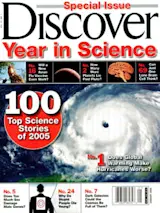Peculiar New Rodent Family Found in Laos
Laonastes aenigmamus is much like a porcupine without spines. When Robert Timmins wandered into a game market in Laos one morning, he happened upon two of the strangest rodents he had ever seen. Each ratlike body sported a carrot-shaped head and a bushy squirrel tail. Last April Timmins, formerly of the Wildlife Conservation Society, reported that further study revealed the creatures were not only an unrecorded species but also representatives of an entirely new family—as different from other rodent groups as cats are from dogs. "In terms of rodents," he says, "nothing this big has happened for a hundred years." He named the species Laonastes aenigmamus, for "rock-dwelling enigmatic rodent." —Jessa Forte Netting
Secrets of Hibernation Seen In Clouds of Hydrogen Sulfide
Spelunkers dread clouds of metabolism-slowing hydrogen sulfide, a gas sometimes found at high levels in caves. Yet that very effect prompted Mark Roth—who learned about it by watching a TV show—to wonder if H2S might be put to use in medicine. Last April Roth, a medical researcher at the Fred Hutchinson Cancer Research Center in Seattle, announced that exposure to hydrogen sulfide induces a short-term, fully reversible state of suspended animation in mice. If the gas can be shown to have the same effect on humans, it might revolutionize organ preservation and general anesthesia and let wounded soldiers survive long enough to reach a hospital. It might even help astronauts endure long stints in space.
Roth put ordinary lab mice in a chamber filled with 80 parts per million of hydrogen sulfide. (Humans can detect the stench of the gas at just 2 parts per billion, and exposure to 1,000 parts per million can be fatal.) Within five minutes the mice flopped down on their bellies and started to get cold, although they continued to groom themselves. After a few hours, the mice had halved their body temperature and their metabolic rate had dropped 90 percent. After six hours, Roth revived them—with no discernible ill effects—by pumping regular air back into the chamber.
Roth thinks he may have stumbled onto a switch involved in hibernation. Hydrogen sulfide is found in small amounts in human blood, he says, and "because of cases where people have survived for hours trapped under ice," he says, "there has been a lot of speculation that the ability to hibernate isn't confined to the relatively few species it's normally observed in."
He hopes to do human studies: "It isn't as far-fetched as it seems," he says. "When you consider that sleep is really just a very mild form of hibernation." —Jocelyn Selim
Pop Went the Toads
A reputation for elegance and order in Hamburg, Germany, was fractured in April by an alarming outbreak of exploding toads. Local amphibians swelled up to triple their ordinary size, then burst—audibly and always at night—with enough force to propel their parts up to three feet. City residents were left to puzzle over a trail of corpses. The site of the happenings was quickly dubbed "the pond of death," and officials scrambled for explanations. Water tests revealed no unusual bacteria or viruses. Suggestions that South American racehorses running nearby had introduced an alien fungus were disproved.
Meanwhile, toads kept going pop in the night. "It's absolutely strange," Janne Kloepper, a veterinarian at the Institute for Hygiene and the Environment, told local media. "We have a really unique story here in Hamburg. This phenomenon really doesn't seem to have appeared anywhere before."
She wasn't able to say that for long. Reports of more exploding toads soon emerged from across the border in Denmark. As the death toll climbed above 1,000 in the space of just a few days, the mystery deepened. No other aquatic or amphibious wildlife seemed to be affected in either country. Even frogs were doing just fine.
Berlin veterinarian Frank Mutschmann descended on Hamburg to collect corpses and perform autopsies. Examining countless specimens, Mutschmann noticed that all the animals had curiously identical incisions in their midsections. Further inspection revealed the cause: Aggressive crows had developed a taste for toads' livers and were plucking them out in lightning-quick strikes. The toads had apparently tried to frighten off the predators by puffing themselves up, and the crow-beak punctures had caused the toads' blood vessels and lungs to rupture.
"The crows are clever," Mutschmann observed. "They learn quickly from watching other crows how to get the livers." The residents of Hamburg remain on guard. Two years ago, a flock of crows attacked joggers in a city park, pecking at one woman's head as though under the direction of Alfred Hitchcock. —Trey Popp














